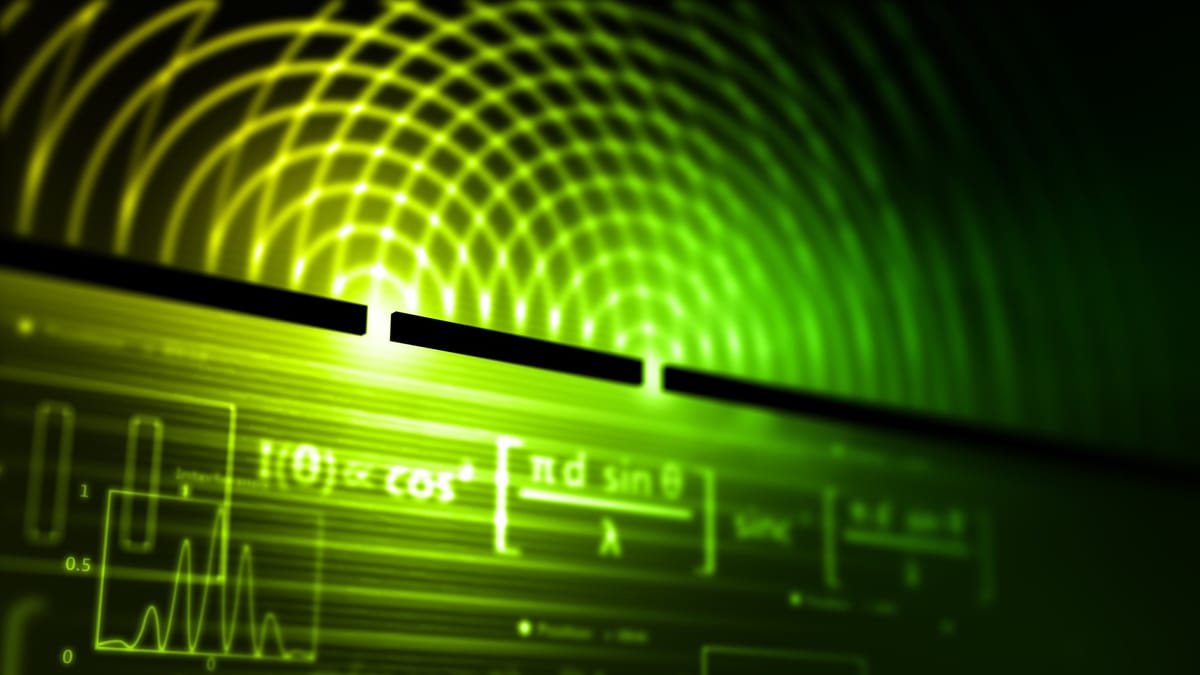The Double Slit Experiment

Introduction
The famous Double-slit experiment is known for providing evidence for the fundamentally probabilistic nature of quantum mechanics. Interestingly, it reveals how electrons and photons switch between particle and wave behaviour following mere observation. The abstract and overarching term “observation” is hard to account for in attempts to explain this bewildering phenomenon, causing some to even suggest the existence of parallel universes interfering with each other, or something as bizarre as our physical reality being controlled by higher beings.
This article aims to formulate a more mathematically concrete interpretation of the experiment’s results, so that no unnecessary assumptions are included.
Classical diffraction
The double slit experiment was first performed in 1801 by physicist Thomas Young, when he had shone a light source at two closely spaced slits, allowing rays of light to pass onto a screen on the other side. The result was a diffraction pattern in which alternating streaks of light and darkness were spread out along the screen, something that was to be expected as it had long been established that light behaved like a wave. If light had consisted of only classical particles, the pattern would instead be the bright, blurry shape of the slits.
This distinction between particles and waves can be explained by how classical waves interfere by superposition.
By the Huygens-Fresnel principle, each point on a wave front is the centre of a wavelet, and thus light passing through the two slits would also generate wavelets spherically outwards in all directions. These wavelets are characterised by their wavelength and amplitude, and what ultimately produces the diffraction pattern is the difference in distance traversed by neighbouring wavelengths, causing the waves to interfere constructively or destructively.
Light waves can be expressed by a function of the form
y=Asin((2π/λ)(x-ct) where t is the time, c is the speed of light, λ is the wavelength and A is the amplitude. The result of interference that is measured (at each point) is the intensity of light impinged on the screen, equal to the square of the sum of y values from all waves concentrated on each point of the screen.
At a given time, a single point on the screen receives waves with the same t values but different x values because x measures the length along the wave. If two waves have x values that differ by nλ , where n is an integer, (we assume that all light waves used are monochromatic), their phases (value in the sine bracket) differ by 2πn, meaning that the waves give the same y values and their sum a high intensity as compared to individual intensities.
If their x values differ by nλ/2 where n is an odd integer, however, their phases differ by πn, meaning that the waves give opposite y values and an intensity of 0.
To see this, sin(A+nπ)=sinAcos(nπ)+cosAsin(nπ)=-sinA(considering n is odd)
For simplicity, we assume viewing distance (distance between slits and the screen) is large compared with separation of the slits d. The path difference between two waves travelling at an angle θ is seen by assuming the slit closer to a given point as being horizontally across the point on the screen. Drawing a perpendicular line from that slit to the line connecting the other slit and the point, we have that the path difference is dsinθ≈dθ (θ is small)
The bright streaks (interference fringe maxima) thus occur at
dθₙ=nλ, n=0, 1, 2, . . . The spacing of the fringes at a distance z from the slits is
w=z(θₙ-θₙ₋₁)≈zλ/d ( arc length = radius ✖ angle (in radians) of the arc)
Particle-wave duality:
In the well-established theory of electromagnetism in the late 19th century, matter was considered to consist of classical particles while light consisted of waves. It was the groundbreaking Davisson Germer experiment that confirmed the suspicions of physicists such as de Broglie and Einstein, who proposed the wave-particle duality of both light and electrons.
The Davisson-Germer experiment showed that electrons, when scattered by the surface of a crystal of nickel metal, displayed a diffraction pattern. However, mystery arises with the introduction of devices that detect which slit a particle had passed through.
Consider the following experiment:
At A there’s a source S emitting electrons of the same energy in all directions to impinge on a screen B. Screen B has two slits through which electrons may pass. Behind B at a plane C we have a detector of electrons which is placed at various distances x from the centre of C.
If the intensity of source S is low enough, and we have an abundance of detectors spread over C, only one detector would respond at a time–there is no half response of a detector, and no two detectors respond at the same time.This is why we say electrons are localised particles.
(*Note that the detector plays the role of the screen in classical diffraction, and simply shows the density/probability of electrons landing on various positions x of screen C)
Adopting this particle model of the electron, we suppose that S would send out corpuscular “balls” that pass through ONE slit and land on screen C. Since these particles can be separated into disjoint classes of arriving from slit 1 or slit 2, the arrival of a particle at point x on C must be the sum of P₁=chance of arrival from slit 1, and P₂=chance of arrival from slit 2. (P=P₁ + P₂)
P₁ and P₂ are easily measured by closing one of the slits, as it is assumed that an electron cannot pass through a closed slit.
This, however, does not align with the experimental results:
Here, the electron density is plotted against position x on C. (a) is the result for opening both slits. (b), (c) show the result for opening just slit 1 and 2 respectively. (d)=(b)+(c). Clearly, (a) is not equal to (d).
The reader ought to expect this as it is precisely what the Davisson Germer experiment had revealed: We should instead treat the travelling electrons as waves, their interfering intensities interpreted as the probability that a particle will arrive at x. In addition, we must abolish the idea that when both slits are open, an electron goes through one slit or the other.
The Effect of Observation:
We test our suspicions by having a source of light behind the slits and watch to see through which slit the electron passes. (An electron will scatter the light in the neighbourhood of the slit it passes through).
This forces the electron to choose only ONE slit, as light is never scattered behind both. Even if one measures the charge passing through each slit, it is either 0 or the whole charge of one electron and never a fraction of it.
The trajectory of the detected electron is mostly unaffected (as photons transfer negligible momentum upon collision) and allowed to impinge on screen C.
Measuring P₁ and P₂, we get (very nearly) (b) and (c) as before. Now opening both slits, we get the staggering result of (d)!
How did we, by simply observing which slit the electron had passed through, alter the possibility of it arriving at point x?
The answer is that to observe an electron, a photon must have collided with it and transferred to it an energy of hν. (h is planck’s constant, v is the frequency) Even if we try to lower frequency ν by using light of longer wavelengths λ=c/ν there’ll be a point where we can no longer tell behind which slit the light is scattered, since light waves of wavelength λ cannot have its position determined with precision greater than of order λ.
In fact, any physical agency designed to determine through which slit an electron passes must produce enough disturbance to alter the distribution from (a) to (d). But how is this “collapse” of probabilities triggered by observation? The following concept aims to provide an explanation.
Quantum Decoherence:
This is a formalism describing how the isolated state of the system we wish to measure (eg.particle in double slit experiment) is entangled with the environment upon measurement, and how this changes its statistical properties.
In quantum mechanics, an N-particle system can be represented by a wave function
Ψ(x₁, x₂, . . ., xN ) (relativistic wave functions are dependent on the particle type, so for simplicity we consider the non-relativistic case), where each xᵢ is a 3D vector.
The original (unmeasured) system’s wave function can be expanded into a linear combination of elements |i〉 that form an orthonormal basis. By orthonormal, we mean 〈i|j〉= δᵢⱼ=(0 if i ≠j; 1 if i=j)
(In the language of linear algebra, a state vector |i〉 is a column of numbers and 〈i|j〉means forming the inner product with the complex conjugate of |j〉transposed.)
If each element of these basis states interact with the environment in an element-specific way, they will most likely be rapidly separated from each other under the time evolution of their independent paths. The original elements coupled to the environment in such a way are said to be “einselected” (environmentally-induced superselection) and no longer exhibit the wave-like quantum interference with each other as in the double slit experiment.
To see how this happens, consider the following mathematical description of decoherence using the notation we have introduced (Dirac notation):
Prior to measurement, the system is in the state |ψ〉=∑ᵢ |i〉〈i|ψ〉where the |i〉form an einselected basis. Let the environment initially be in the state |e〉
Since the system is independent of its environment before measurement, the total state of these two subsystems combine in a tensor product |i〉 |e〉 (they basically occupy independent dimensions)
|before〉=∑ᵢ |i〉 |e〉〈i|ψ〉
In an idealised measurement, the system disturbs the environment, but is itself undisturbed by the environment and thus forms a tensor product with an environment basis vector corresponding to it.
|before〉evolves into |after〉= ∑ᵢ |i,eᵢ〉〈i|ψ〉= ∑ᵢ |i〉 |eᵢ〉〈i|ψ〉
Similar to before, we have 〈eᵢ|eⱼ〉≈ δᵢⱼ (where we have replaced the optimal situation of = with ≈ since there might be hidden correlation between the environment basis states.)
Now let’s see how the environment takes away quantum interference between einselected basis states in the probability of transition between two states |ψ〉and |ф〉of the system.
Born’s probability rule states that
probbefore (ψ→ф)=|〈ψ|ф〉|² =|∑ᵢψᵢ*фᵢ|² =∑ᵢ|ψᵢ*фᵢ|² + ∑i,j, i≠jψᵢ*ψjфᵢ фⱼ*, where ψᵢ=〈i|ψ〉
ψᵢ*=〈ψ|i〉, and фᵢ =〈i|ф〉etc. (* means complex conjugation)
Notice that the last term is a mix of coefficients corresponding to different basis vectors. This may be interpreted as the quantum interference within a state.
probafter(ψ→ф)=∑ᵢ|〈after|ф, eⱼ〉|²=∑ᵢ|∑ⱼψj*〈i,ej|ф, eᵢ〉|²=∑ᵢ|∑ⱼψj*фᵢ〈eᵢ|eⱼ〉|²
In the second step, we have summed the probabilities of transitioning into each einselected state of ф.
probafter(ψ→ф)≈∑ᵢ|ψᵢ*фᵢ|²
Since each evolved einselected basis is a state of its own and not merely a basis, as in |before〉, all the quantum interference terms ∑i,j, i≠jψᵢ*ψjфᵢ фⱼ* have vanished from the transition-probability calculation.




